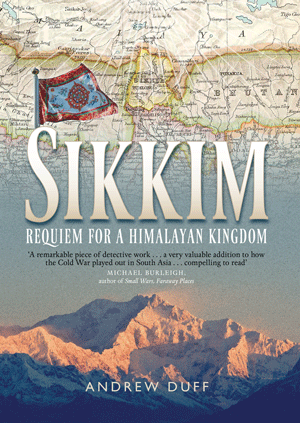One of the great things about independent traveling is that you can change your mind at a whim. So that’s what I’ve done.
Some background…
A couple of years after coming to India, my grandfather and three of his friends all in their early 20s, took a trip up to Darjeeling. Being adventurous types, the four of them then embarked on an 80-mile trek through South-West Sikkim on foot. (Darjeeling is the gateway to the Indian state of Sikkim, formerly an ancient Buddhist kingdom, which is perched precariusly between Nepal, Bhutan and China).
My grandfather wrote the trek up in 10 fascinating type-written sheets entitled “A Ten-day tour of Sikkim, October 1922”. It has details of the route which covered 80 miles through the villages of the area, estimated distances covered each day, information on where they stayed (old style “hill bungalows”), and is accompanied by about 20 well-preserved photos.
The best-laid plans…
Naturally, on leaving London I had been excited about the possibility of following the same route. But when I arrived in Darjeeling a week ago, all the guides I spoke to in Darjeeling explained one-by-one that this trip wasn’t really practical now. “Things have changed…” they said. “There won’t be anywhere to stay…” they added. “And anyway how about this nice high-altitide trek?”
It was disappointing, but slowly I was persuaded that redoing the “Ten-day tour” was just a pipe-dream. I reluctantly convinced myself that a different trek would be just as fun.
So I hired the best guide I could find, Shradha Gissing, and made an alternative plan. Shradha (who also happens to be the only female guide in Darjeeling) would take me to her village in West Bengal for a couple of days; we would then take a jeep to a couple of the places mentioned by my grandfather. She would pass me to another guide for the popular 10-day Goecha La trek (a high altitude trip to 5000m to gaze up at Kanchenjunga) in a group with a few others.
That was the trip I proudly announced a couple of days ago.
Make-a-your-mind-up!
But when we got to the beautiful village, something was still gnawing away at me. Why couldn’t the trip from 1922 be done? Surely it couldn’t be that hard?
As we sat eating by an earthenware stove, I shared my frustration with Shradha. I told her I wanted to have one more go at working out the 1922 trip. I asked for a couple of hours to think.
I went to my room, and pulled together everything I had – a 1982 Government of India map bought in Calcutta; my “Rough Guide to India” (with patchy details of the area); the photocopied pages of my grandfather’s route; and finally a book that Shradha’s father had treasured for years and that she had lent to me, entitled “Darjeeling District since 1835”. (Published in 1916, this book later proved to have valuable details of some of the villages on the route).
A couple of hours later, Shradha knocked on my door. I shared what I had found. As we worked through the details into the evening, we both started to realise that it really might be possible. Inevitably there would be a cost to cancelling the high altitude trek, but we reckoned we could still stay within the same budget. I slept on it.
By the next morning, it was so obvious to me that this was the right thing to do. So I am now back in Darjeeling, where we have spent the last couple of days excitedly planning everything. Barring one bridge which no longer exists, we should be able to follow the trek fairly faithfully. Some of the other (previously nay-saying) guides have already been sniffing around for details of how it will be done.
One last thing for amusement. In my grandfather’s type-written notes, there is a section entitled “Kit”. I reproduce it in full. It says:
“KIT. As little as possible is a good maxim. A valise with two blankets and a razai (or quilt) to lie on is all that is required up to 7000 feet. One suit case should carry all other requirements. For dress, stout boots well-dubbined are good, also serge shorts, a thick grey flannel shirt, putties (not always necessary) and a good thick topee as the sun is strong during the day. Thick socks are practically an essential, while lux and darning wool are also useful. Plenty of reading material and paper for writing should be taken. A good sharp knife and a rope are handy. As regards medicines, iodine and Eno’s are the most necessary. A sweater should be carried during the day, and put on at night, when it gets much colder. Candles are always useful as the bungalow lamps were not always in working order. It might be advisable to take a good lamp as well as the hurricane “buttis”. A kettle should be carried for mid-day tea; other useful items in the tiffin equipment are “jharrans” or dish towels, a ground sheet, and papier mache napkins, while of course cups, plates, and cutlery are required. Some small change is necessary but a small amount will suffice.”
Clearly “as little as possible” meant something different when you had a train of 10 porters, cooks, sirdars – and a couple of ponies.
We set off tomorrow morning. With a rucksack each. I will be back on 18 April.



